Is using generative AI ethical? Recently, we wrote an article about how generative AI tools like ChatGPT are increasing two problems that content marketers have been facing ever since that term became popular: noise and cynicism. There’s just so much content out there, we can’t possibly digest it all – and how do we know if we can trust it?
Another place where we’re facing information overload and a lack of clarity around what we can trust is in the subject of generative AI and ethics. Are the evangelists misleading us with their enthusiasm? Or are the naysayers overhyping the dangers? And how should we navigate the advance of these technologies, especially as values-led businesses?
At RH&Co, we’re keeping an open mind when it comes to generative AI. On the one hand, we’ve been experimenting with how useful it can potentially be to us and to our clients. But as a B Corp, we’ve also been looking into the darker side of AI, so that we can build out our own policies in a way that supports the planet and its people.
TL:DR
- A caveat before we start
- Environmental concern: generative AI’s use of electricity and water
- Misinformation: Hallucinations and fake news
- Human rights and ethics: what about the people?
- How should values-led businesses respond to generative AI?
A caveat before we start
First, let’s clarify the language. This article by the Harvard Business Review does a great job of distinguishing between important AI terms such as generative AI, machine learning, natural language process and so on.
It’s important to understand that what we’re talking about in this article is the tools that respond to human prompts by creating content in one form or another. Tools like ChatGPT, Dall-e, Midjourney and so on.
Secondly, we’re not discounting the many ways people are finding tools like these helpful, from helping to overcome dyslexia when writing emails or internal reports, to creating summaries of meetings for quick reference.
Generative AI is changing rapidly, and to discuss the merits of individual tools and their current abilities would make this article redundant almost as soon as we hit publish. Instead, when asking “Is generative AI ethical?”, we want to look at the broader issues that underpin the use of this technology so that we can ensure that, as a user group, we call for a version of AI that doesn’t sit contrary to our values.
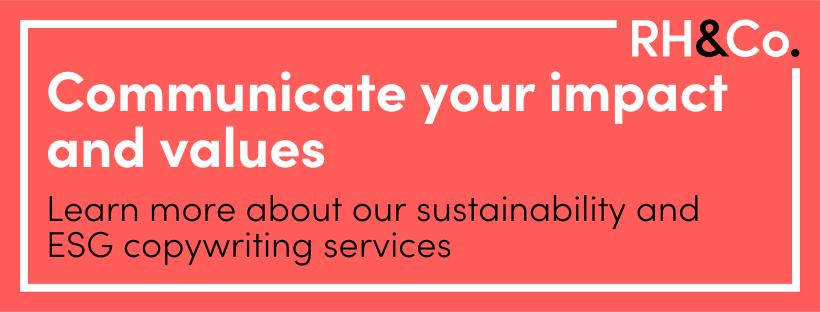
Environmental concern: generative AI’s use of electricity and water
Every time we use digital technology, we use energy. Not just the electricity that goes into powering our smart phones and computers, but the energy that goes into sending our emails, storing our documents and connecting our video conferences. As a result, every individual and organisation now has a digital carbon footprint.
Generative AI is adding to this footprint. There’s the energy needed to develop and train the models, not to mention the energy needed to complete a query. While there are no straightforward answers when it comes to how much energy AI uses – as this article by a Boston University computer sciences professor showcases – it’s clearly something we need to consider.
The same goes for water use, as this article in The Independent highlights. One of the studies referred to in the article, by researchers at the University of California and University of Texas, suggests that “training GPT-3 in Microsoft’s state-of-the-art U.S. data centers can directly evaporate 700,000 liters of clean freshwater”, and that “global AI demand may be accountable for 4.2-6.6 billion cubic meters of water withdrawal” by 2027.
This is not to say that we shouldn’t use generative AI. But using it arbitrarily when other options are available feels like an unnecessary way to increase our digital carbon footprint and water use.
Misinformation: Hallucinations and fake news
Lying and misleading people isn’t a new phenomenon – it’s been around as long as the human species has. But it’s easier to mislead today than it’s ever been, and to do so at scale.
This study, published by Cambridge University Press, looks at the role of artificial intelligence in disinformation. In the abstract, the researchers state that AI systems “boost the problem [of disinformation] not only by increasing opportunities to create realistic AI-generated fake content, but also, and essentially, by facilitating the dissemination of disinformation to a targeted audience and at scale by malicious stakeholders.”
In some cases, people are deliberately using generative AI to create fake content, as with the video of Australian businessman Dick Smith supposedly promoting an investment opportunity – or the numerous examples cited in this Sky News article.
But there’s also the challenge of AI ‘hallucinations’, where tools like ChatGPT make up answers rather than admit they don’t know something. Read our article about how AI is increasing noise and cynicism for a prime example involving our very own James Matthews.
Again, although none of this means we should avoid generative AI entirely, it does pose the question of how we regulate it and how transparent we are about using it.
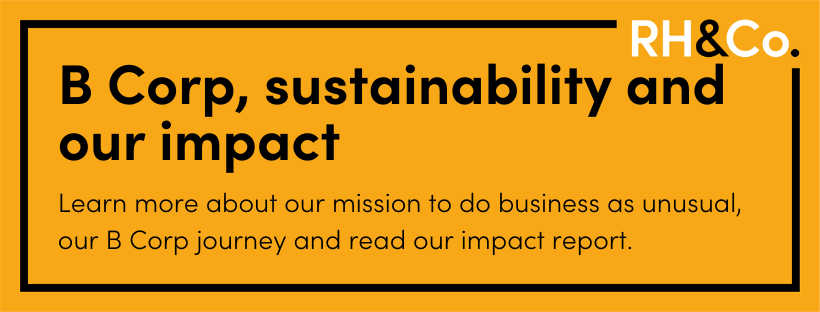
Human rights and ethics: what about the people?
How do you get an AI to decide whether text contains inappropriate or offensive subjects? Easy – just get humans to read the text and tell the AI whether it’s acceptable or not. Except imagine you’re one of those people. What’s that going to do to your mental health?
That’s the issue that faced content moderator Mophat Okinyi when he worked for Open AI (the creators of ChatGPT) in Nairobi, Kenya. The text and images he was required to review depicted a variety of scenes too unpleasant to go into here, leading him to become withdrawn and paranoid, and ultimately resulting in the breakdown of his marriage.
Obviously this is an extreme case but there are other ethical issues that we need to consider when it comes to generative AI. This quote from UNESCO’s Assistant Director-General for Social and Human Sciences, Gabriela Ramos sums up the breadth of the challenge: “AI technology brings major benefits in many areas, but without the ethical guardrails, it risks reproducing real world biases and discrimination, fueling divisions and threatening fundamental human rights and freedoms.”
For those of us in creative industries, a big concern is the way that generative AI is trained on work that human beings have produced and may not have shared reproductive permission for. Is training generative AI the same as an artist being inspired by viewing the works of others, or is it an infringement of copyright?
It’s not a straightforward answer. An article in Harvard Business Review stated that “the legal implications of using generative AI are still unclear, particularly in relation to copyright infringement, ownership of AI-generated works, and unlicensed content in training data.”
How should values-led businesses use generative AI?
So, is using generative AI ethical? We’d love to say that we had a simple answer, particularly as a B Corp that believes in doing business as unusual. Unfortunately, the issues aren’t clear cut, not least because the technology and the regulations surrounding it are changing virtually every day.
So what should we do? Well, we can only say what we at RH&Co are doing, which is staying informed, actively seeking out a variety of viewpoints, experimenting and testing, and keeping an open mind.
Our plan is to draw up an AI policy in time, and when we do we will be sure to share it here on our website. If you have any thoughts, suggestions or resources to share, we would be very happy to receive them.
AI is not going to be the end of the world as we know it but it is going to have an enormous impact on it. Let’s work together to ensure that it is a positive one for our planet and all of its people.
A few weeks ago, we attended a marketing conference in Bristol. We made it roughly eight minutes into the initial coffee-and-hello part of the event before someone asked us The Question: “So, how much is AI impacting what you do?”
We get it; everyone wants to talk about ChatGPT and the ramifications for writers these days. Us included – barely a day goes by without at least one conversation about AI, from the ethical questions around its use to how it will make it more difficult to cut through noise and cynicism.
Having seen generative AI at work, we’ve always been pretty confident that it won’t be replacing great human writers any time soon. But while it might not be up to crafting an expert-led article or inventive web copy by itself, we didn’t want to write it off entirely without giving it a good faith go at showing what else it’s capable of.
So for the last few months, I’ve been experimenting with adding AI into the work we do – not having it produce content for clients but asking what other parts of the creative process it could help make more efficient.
ChatGPT doesn’t have a creative bone in its binary code
Getting past the blank page
One of the first experiments I tried with ChatGPT was seeing if it could speed up the process of creating a blog outline. Not write a blog by itself – just to take our notes from a briefing or the transcript of a client call and order the key points into a skeleton we can then write from.
The results were mixed at best but let’s start with the positives. I was surprised at how well ChatGPT could identify the key points of a conversation from only a video call transcript and not only list them out but also provide bullet point summaries of what a client had said around each point.
But when it came to threading those points together into a blog outline, the limitations hit hard. For one, ChatGPT doesn’t have a creative bone in its binary code, so it couldn’t identify any narrative behind the key points it had picked out. It could only create an outline that followed the same course as the conversation, from one point to the next, neatly tucked between a school essay-style intro and conclusion.
It also struggled with the idea that each key point doesn’t need to be a separate section. If given little instruction, it would simply turn each element of the conversation into its own subhead. The result would be a dozen or more sections, plus intro and outro – way too many to squeeze into a +/- 1,000-word article.
If I got more detailed in my prompts, specifying 3-4 subheadings and asking it to group certain key points together to make one blog section, it would get confused. Sometimes it cut down its previous attempt to four subheads by cutting off the bottom eight rather than grouping things together. Other times it just hallucinated and returned any random number of subheads with an apology after for not being able to count to four.
To structure an article, you have to be able to discern – not just what was said in a briefing call but which points are most relevant to the topic at hand, and what narrative thread links them together in the way that’s most interesting to the person reading. And as it stands, that’s just not in ChatGPT’s wheelhouse right now.

The world’s most eager research assistant
Given that one of ChatGPT’s primary goals is to help people find information fast, I was curious how well it would function as a research assistant. Researching can sometimes be the longest part of writing an article. You know the right statistic is out there but finding it on a site that isn’t disreputable, out of date or, worse, a client’s competitor can be a slog. So any way that AI could speed that up would be a huge win.
There are two obvious problems to work around here:
- Hallucinations. The hardest thing ChatGPT can do is say it doesn’t have an answer, which means if it can’t find the stats you’re asking for, there’s a good chance it will make up results instead. You can ask ChatGPT to provide sources for its answers, but that doesn’t stop it from creating false stats – it just makes it quicker to fact check them.
- Recency. ChatGPT’s training data has a cutoff date, meaning anything published online after that isn’t in its knowledge banks. If you’re looking for anything from the last year (at time of writing, the free version powered by GPT-3.5 is only aware of events up to January 2022), ChatGPT simply cannot help.
But there was one other problem I didn’t expect to find when using ChatGPT to help with research. When it comes to research to support blogs, we’re not just looking for stats that back up what we want to write – we’re also looking for details we hadn’t considered before that spark new ideas and enrich the content.
For example, I was recently writing a blog about the importance of translation and localisation in the adoption of new tech products. When ChatGPT couldn’t return any relevant stats showing that localising marketing materials or UI does lead to greater adoption, I went searching myself. And while I didn’t find the stats I was looking for, I did find ones breaking down the proportions of non-English speakers in predominantly English-speaking countries.
It wasn’t the information I was originally looking for but it did lead me to a worthy point about the need for multilingual marketing even if you’re not planning to sell your products outside of one market – for example, Spanish in the US or French in Canada. But because ChatGPT is designed only to reply to the prompts you give it, it would never have been able to join the dots like this and suggest an angle I hadn’t yet considered.
Optimising articles for SEO
So when it comes to outlining blogs and sparking ideas, ChatGPT isn’t the best. But what about when an article is already written and just needs to be garnished with SEO keywords?
I figured this would be a simple experiment. I give ChatGPT the text of the article and a list of the necessary keywords, ask it to pepper them throughout the blog at least once each, and see what it does. SEO optimisation isn’t a particularly time consuming task, but any way AI could speed that up would be helpful.
Or so I thought.
On its first attempt, ChatGPT returned the exact text of the blog I’d pasted into my prompt. No alterations, no keywords, nothing. Just a word-for-word replica, and the proud assertion that it was a revised version.
After I pointed out what had gone wrong the first time, ChatGPT tried again. And to its credit, it did at least include most of the keywords this time – although they were all added on to the end of random paragraphs and with no accompanying sentence or context. Just… keyword.
I wondered if my prompt was the problem. I’d originally asked ChatGPT to add these words with minimal alteration to the blog itself, so for the third attempt I specified that it could make changes to the body text, such as adding new sentences in the middle of paragraphs, in order to insert the keywords. Just to be on the safe side, I also explicitly asked it to insert the keywords into paragraphs and not tack them onto the end as it had done before.
Third time’s the charm, right? Except… not quite. My attempts to cover off any loopholes or confusion in my prompt just led to ChatGPT returning the exact same copy as it had in its second response. The same keywords in the same places as before. I gave up and did it myself.
My theory on why this went so wrong comes back to the fact that ChatGPT can’t discern like humans can. Inserting SEO keywords might look like a simple find-and-replace job, but there’s more to it than that. To weave in terms without them feeling intrusive to the reader, you have to be able to look at the wider context of a paragraph or whole section. You have to understand which phrases are relevant to which key points in the article.
In other words, you have to use judgement and a little creative thinking – and as we’ve already established, neither of those are qualities ChatGPT can boast.

So… was using AI ever any quicker?
As I’ve been experimenting with AI, there’s one question that keeps coming to mind. It’s not “Is ChatGPT good enough to do X, Y or Z for me?” Instead, it’s “Am I just using AI for the sake of using AI?”
Let’s go back to blog outlines for an example. While ChatGPT falls short when it comes to narrative structures, there are some other kinds of content where AI can actually help. When we’re writing longer form pieces with a focus on SEO, it can help to have ChatGPT lay out distinct talking points in a linear fashion. And because it creates its responses from scraping its banks of training data, the subheads it suggests are usually pretty SEO-friendly.
But structuring a pillar page or a longform SEO piece is rarely something that needs speeding up. Unless you’re writing about a topic that has genuinely never been covered before, it’s pretty evident what information readers need to see and how you need to order it.
So does AI actually make this process any faster? Not really, no – or at least not enough for us to change our entire workflow and become part-time prompt engineers.
We’re all asking questions about AI at the moment – is it good enough, is it ethical, is it the thin end of the robot apocalypse wedge? Often those questions feel like they’re way too big for an individual to answer.
But there’s one question we should all be able to answer, AI expert or not – is using AI for this task worth it? Are ChatGPT, Bard, Dall-e and the like helping you to do something faster, to free up time you can better use elsewhere? Or are you just using them because they’re shiny, they’re new and they’re available?
Because if artificial intelligence can’t help us be any more effective or efficient where we need to be, we might be better off sticking with the intelligence we already have.
RH&Co founder, Rin Hamburgh, recently hosted an ‘Ask me anything’ webinar, answering your questions on all things B2B content strategy and planning for 2024. If you didn’t see it live, you can watch the video recording or, if you prefer your content in written format, have a look at the Q&A answer summaries below.
TL:DR
- What content should I prioritise if I have limited resources?
- What types of content are best outsourced vs done in-house?
- What’s the best way to measure how effective content is?
- Where should you publish blogs or articles – on your website or on a platform like LinkedIn, or Substack or Medium?
- What is the most common mistake you see people make with blogging (or content generally)?
- I’m struggling to get our technical experts involved in creating the content – do you‘ve any tips?
- Are case studies still useful content for B2B businesses, and if so, what format should they take?
- We have a big bank of podcast content – can we turn it into a blog series, and if so, how?
- What kind of content should you be sharing in a newsletter?
What content should I prioritise if I have limited resources?
Deciding what content to produce all starts with your business goals. Different types of content (and the different channels through which you can share them) are effective in different ways. So it’s important to understand what you’re looking to achieve – whether that’s scaling brand awareness, breaking into a new market, or increasing SQL conversions – so you can focus on the most appropriate content and channels.
You also need to understand what resources different types of content will require. For example, running paid ads requires a financial commitment over an extended period of time. On the other hand, posting regularly on LinkedIn takes time (and skill) but doesn’t necessarily have to cost anything.
In terms of putting all of this together into a strategy, think about your content priorities and frequency in terms of what LinkedIn’s Purna Virji calls ‘hum, sing and shout’ content:
- Hum: some lower level content to create consistency and maintain brand awareness over the long term.
- Sing: periodic small campaigns designed to achieve specific goals such as educating your audience on a key topic or going after a specific industry vertical.
- Shout: occasional hero content campaigns to support an important business objective such as a new product launch.
If you’re really pushed on resources and have to put all your eggs in one basket for the short term, think about where you can get the biggest wins most quickly. Do you have a large client database you could reach out to with a reintroduction or referral email campaign? Have you recently completed a prestigious project that you could use to create a case study or enter an award?
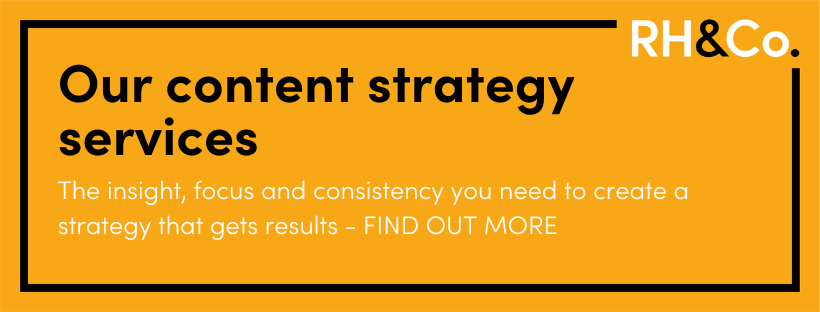
What types of content are best outsourced vs done in-house?
Naturally the biggest part of the decision about what content to outsource vs produce in-house is going to be what skills you and your team have. While many marketers have some practical delivery skills such as writing or design or videography, it’s likely you won’t be able to do all of them to the same standard as a specialist.
This might not be a problem. You’ll need to think about the standard required for your content. For example, if you’re filming an important explainer video, you might want a professional videographer involved. But if, like us, you’re doing a webinar Q&A, you can probably use the software on your laptop to film and edit it together on a shoestring.
What many of our clients do is engage us to create the larger, more complex pieces of content such as white papers or thought leadership articles, and then do the repurposing of that copy in-house to create social media content. In a similar way, you would need to get a design or branding agency involved in creating your visual branding in the first place, but could then go on to use that branding yourself to create ongoing design assets in-house.
What’s the best way to measure how effective content is?
Measuring content effectiveness starts with setting goals and then defining what metrics make most sense for that goal. Each type of content and each goal will have different metrics that you might want to track, so there’s no one best way. However, it’s important to think about two key things…
First, be specific. If you’re sharing thought leadership content on LinkedIn, don’t just look at how many impressions or engagements you’re getting. Think about whether you want those impressions and engagements to come from people in a particular industry sector or at a particular level of seniority, and track that.
Also, make sure your metrics are relevant. Taking the thought leadership example again, the likely goal for this is brand awareness. So measuring leads generated is probably a bit of a stretch. But if members of your expert or senior leadership team are invited to do a speaking engagement or be a guest on a podcast, that could be considered a relevant win.
Where should I publish blogs or articles – on our website or on a platform like LinkedIn, or Substack or Medium?
There are advantages and disadvantages to posting blogs or articles on a business website vs a social media platform like LinkedIn or a publishing platform like Substack or Medium.
One key issue is ownership. You own your website and therefore have control over it. Whereas on Substack, for example, the platform might disappear tomorrow, or it may require you to pay money in the form of promotions in order to get your articles in front of more people.
Posting to your website is also a way to attract people to that site, whether through SEO or organic social posting, where they can be exposed to more of your brand, products or services.
That said, not everyone is going to be willing to invest the time to click through to a post on your site – which psychologically feels like more of a commitment – whereas you might hold their attention for that bit longer if they can read within the platform they’re already on.
Ultimately your choice should be linked to your goals. If that goal is to raise your profile and grow your network within a given community, posting your content within that community can be very powerful. If, however, you want to drive traffic to your site and get people exploring your offering further, you might be better off posting the articles to your site and then sharing smaller snippets on social media.
This two pronged approach offers the best of both worlds, giving the browsers a taste of your brand and messaging while still allowing you to reap the benefits of hosting the larger content on your own site.
What is the most common mistake you see people make with blogging (or content generally)?
The biggest mistake we see people making with content is not thinking strategically enough about it. Often this shows up as writing about what they want to write about rather than considering what their audience wants to read about.
Another common issue is being too sales focused at the wrong time. You can’t write a top-of-funnel thought leadership piece and then follow up with a sales CTA like ‘book a demo’. It’s important to see content as a way of moving people along the customer journey, step by step.
A third mistake is giving up before they’ve invested enough time in content as a tactic. Content marketing can take time to build momentum – online marketing guru Neil Patel says you need to give it at least 6 to 9 months, while Joe Pulizzi, author of Content Inc, writes that it’s more like 12 to 18 months. It’s also not always easy to see the results on the bottom line, especially when it comes to brand building content, so make sure you set realistic and relevant goals that you can track your progress against.
I’m struggling to get our technical experts involved in creating the content – do you have any tips?
Getting subject matter experts involved in content creation can be difficult because they’re usually very busy and often feel they have better things to do. If they’re not sold on the idea of content, or marketing in general, you’ll need to start by making the case for why it’s important.
When they do get involved, make sure you’re not taking more of their time than you have to. Do your research and use whatever time they have available to get the information from them that only they can provide – the anecdotes, experiences and insights that are so important for expertise-based content.
We have a lot more tips on this subject in our blog post, ‘Involving experts in content creation: a guide for marketers’.
Are case studies still useful content for B2B businesses, and if so, what format should they take?
Absolutely. Case studies can be a very powerful tool for B2B marketers and sales people – particularly those in service businesses. They’re a way of demonstrating the value you offer in a real world context, and this is especially useful when your offering is complex or intangible.
Like testimonials, case studies let your customers talk on your behalf. If you say your product or services are effective, that’s one thing. If someone else says it, that’s much more impactful.
Also because human beings love stories, case studies are that much more engaging to read than a process document.
In terms of format, there are four key elements you need to include:
- A summary of who the client or customer is – their industry, size, business model, anything that will help your ideal target to see you’re a good fit for them too.
- The problem they were facing when they came to you. You might also want to describe what the real underlying problem turned out to be after your diagnosis.
- What you did to support the client in overcoming that challenge. Paint a picture of what it was like to buy from or work with you.
- The results you delivered. Sometimes these will be tangible and quantifiable, such as money saved or revenue increased, but your outcomes might not be so measurable. In that case you’ll need to include qualitative elements such as quotes from the client.
A final point: if your case studies are long, it can be helpful to include a summary of key points at the top of the page.
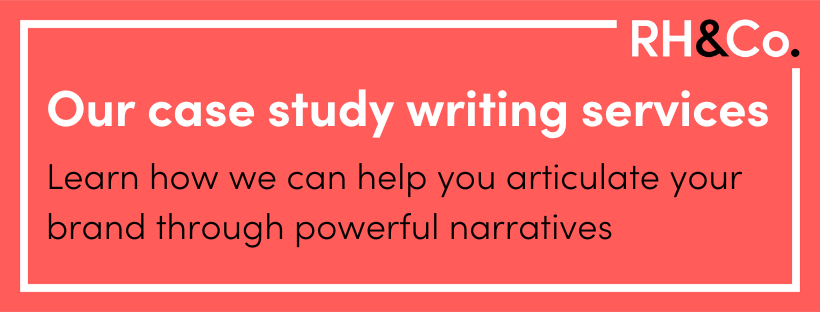
We have a big bank of podcast content – can we turn it into a blog series, and if so, how?
Repurposing content by translating it into a different format is a great way to maximise your return on investment. You can absolutely turn a podcast into a blog, with a different approach depending on what type of podcast it is.
For a host plus guest podcast: Usually these podcasts follow a Q&A format, which translates perfectly into the written form. Depending on the length of the podcast and the guest’s answers, it’s likely you’ll need to edit both questions and answers, making them more concise and suitable for a reading audience, rather than a listening one.
For a panel podcast: This is where you have several people all chatting about a particular subject. In this case, the subject matter is front and centre, so think about writing a blog post that addresses the topic, and use pulled quotes from the podcast to highlight key points. This sort of blog post will feel a lot like a newspaper or magazine article.
Using the full transcript: You can also publish the full transcript of the podcast. This doesn’t make it a blog post, but it can be helpful for those who have listened and want to go back to a certain point by searching for a keyword. It’s also super low effort – just get an AI translation tool and then go through to edit out the ‘ums’ and mistakes.
What kind of content should I be sharing in our company newsletter?
Newsletters are usually sent on a regular basis to a database of readers who have signed up to receive them, and the content tends to be informational, inspirational or otherwise valuable in some way, rather than overtly salesy.
In general, newsletters tend to fall into two main categories…
The first is the long form newsletter. This could include the whole text of a blog post, for example, so that those who are subscribed never miss a post. Or it could be a letter format written to the readership – essentially an article but with a more intimate feel, since it’s written for and to the members of a specific group.
The advantage of this sort of newsletter is that your reader doesn’t need to click through to a different location in order to read all of your content. All you have to do is convince them to open the email and start reading, and then keep them engaged.
The second type of newsletter is the roundup. This is where you have several different sections, each of which has a small amount of text and most likely a link or CTA button leading to more.
This is a great way to share on more than one topic without the newsletter becoming unwieldy. Your reader will feel that they can browse and choose just the items that interest them, clicking through if they are interested in finding out more. It can also be useful for personalising future content, using clicks as an indicator of interest.
Here’s what we include in the RH&Co’s The Right Words:
- Introduction – a chance to say hi and set out what’s in the rest of the newsletter
- Two blog posts – usually our most recent plus a popular one from the archives
- Word of the week – A favourite unusual word and its definition (this is a reader favourite!)
- Industry news – something we’ve read or watched that we think our readers will find helpful or interesting
- Our news – something we want to share, whether it’s an upcoming webinar or a new ebook
- Social link – A call to follow us on LinkedIn and see more of our content more regularly
Have you got a question?
Get in touch and let us know. We’ll be sure to update this article with relevant questions as often as we can!
Translating content into other languages has never been easier. You don’t even need a human translator. From Google Translate to Alexa, there are dozens of AI-powered tools promising to produce versions of your marketing and sales materials for consumption in any country you choose.
Except the reality is that if you give a piece of AI-translated content to a native speaker, you’ll soon find that there are problems. And not just with the language itself – the nuances, the colloquialisms, the most up-to-date expressions – but with what different cultures want and expect from that content.
We’ve been speaking to Anja Jones, founder and MD of fellow B Corp agency, AJT, about the importance of localisation and the benefits it offers to international businesses, from reaching new audiences and building brand trust to improving SEO and website conversions.
How would you define localisation?
Localisation, as the word suggests, is about adapting to a local market. Localisation goes way beyond translation in that it looks at the entire user/customer experience.
The aim of localisation is to build trust in prospective and existing clients. Trust is built more easily when things feel familiar. Just imagine yourself visiting a website from a company that’s based abroad. Being able to browse the website in English is already a huge help in accessing information – perhaps reading about a product and how it works, or understanding how the shipping works.
But beyond language, there are other things that might influence our buying decisions. The way a website is designed – is it laid out in a way that we’re familiar with? In Western Europe, websites tend to be ‘clean’ and minimalistic with plenty of white space, carefully placed images and small amounts of text. Compare that to websites in Asia, which are typically rather busy, densely packed with images and text.
Next, does the website offer payment methods that I’m familiar with? When you shop on a German website for example, you might find payment options British online shoppers are not really familiar with, such as SEPA Direct Debit and buying on invoice.
I believe we always need to come back to the purpose of the content we create, and what impact it needs to have on the reader, whether in the home market or abroad.
When it comes to written content, localisation is about adapting the translation to make it really relevant to the reader in the local market. This could be obvious things like converting currency and pricing from pound sterling to EUR; swapping out links so they lead to the localised version of your website, or swapping out external links (e.g. if referencing a study or particular piece of research) to make sure they’re really relevant to the local reader.
Localisation also means identifying which pieces of written content will be relevant and useful in a local market, and which ones don’t need to be localised at all. Instead of translating your entire library of blog articles, for example, it’s worth analysing which content pieces will be relevant in the local market. This involves carrying out multilingual keyword research to determine if there is any search volume for a particular topic before pushing the button on translation.
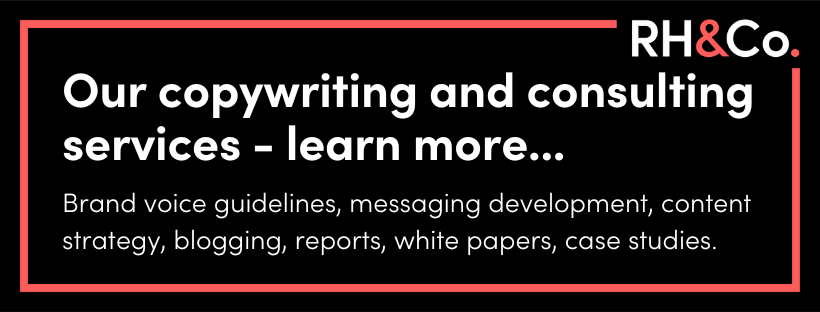
Wouldn’t it just be easier to write more internationally focused content that doesn’t need localisation?
Some say that when you create content that will be translated for an international audience, you should approach the content creation differently from the off. For example, you could use less hyper local references to make the translation process easier and faster.
On the flipside, others argue that professional translators are of course able to adapt cultural references and warn against watering down content to make it more easily palatable to everyone.
I can empathise with both sides of the argument but I believe we always need to come back to the purpose of the content we create, and what impact it needs to have on the reader, whether in the home market or abroad.
Localisation ensures that the content really lands well and has the desired impact. So the important thing is to be aware of cultural nuances and either build language capabilities and cultural sensitivities in-house or bring in an external partner who can bring that cultural understanding to your team.
If a company has taken the brave step of exporting, it’s vital to invest in language and localisation services to ensure the company enters the new market on the right foot.
Can you give us an example of how cultural differences might impact the way content needs to be written?
When you look at US marketing material, it tends to be very enthusiastic and upbeat, using plenty of superlatives and buzz words like amazing, great, fantastic and so on.
When we translate for a European audience, we often need to dial down that level of enthusiasm. Germans, for example, are well known for being quite analytical when making purchase decisions. Any marketing claims really need to be backed up. Facts and figures are reassuring, while overly enthusiastic rhetoric can come across as over the top and unbelievable.
This can and should influence the content creation process. Of course, you shouldn’t change your successful content formula for your English audience, just to make localisation easier. But knowing what German readers need means you can provide those facts and figures to the translation / localisation team so they can incorporate them into the localised copy.
This way you can truly adapt not just words and tone but go deeper and address cultural differences in behaviours and expectations.
Why should people consider using a human translation service?
Using professional translation services is about bringing that understanding of cultural nuances to your company. Anyone can run a text through Google Translate and provide a translation that may at best be a word-for-word translation of your original text or at worst an offensive, inaccurate or incoherent translation that could hinder growth in the local market – or even cause quite serious brand damage.
If a company has taken the brave step of exporting, it’s vital to invest in language and localisation services to ensure the company enters the new market on the right foot. Language and communication are so important in building trust in a new market, and cutting cost corners at the beginning of an export journey by not translating or by relying on free online tools, will only slow or hinder growth.
It may seem like a big investment at the start of an export journey but in our experience, it’s always more costly (not to mention more painful and time consuming) to fix bad translations than to invest in professional translation services from the start.

How does location and translation impact SEO keywords?
Keywords are hugely important for international SEO. Translating your content is crucial for aiding understanding and building trust. But you also need to use the right words and phrases in your translation to ensure your content shows up in search engine results when potential customers search for your type of products or services online.
Keyword research should be incorporated into the translation process from the start so that copy doesn’t just get translated but is keyword-optimised at the same time.
Let’s say you’re selling organic babygrows, and your English focus keyword is babygrow. In German, you can call a babygrow a Strampelanzug, or a Strampler. Strampelanzug is searched 590 times on average a month in Germany, whereas Strampler is searched 9,900 times. Choosing the most relevant keywords before starting with the actual translation can have a really positive impact on your international SEO.
What is the difference between translation and transcreation?
Transcreation is a specific term used for highly creative copy where a straight-forward translation might not work. A port-manteau of translation and creation, transcreation takes the key message of the source copy and creates something equally compelling for the target language.
It’s typically used for ad copy, headlines, slogans and other creative short form copy. In transcreation, linguists essentially have greater freedom to step away from words or sentences and really focus on the impact the text needs to have on the reader. What emotion it needs to elicit, what actions it should inspire the reader to take.
Creative copy often involves word play, which might use literary techniques such as rhyme, rhythm, alliteration, and so on. It might also draw on cultural references. You can’t easily translate these, they need to be recreated for each language.
Having said that, both translation and transcreation require creativity and cultural sensitivity to create localised copy that truly resonates with readers in the market.
For more about translation, transcreation and localisation, visit the hugely valuable AJT Insights blog, where you can read about everything from app translation to the difference between how Germans and Austrians speak, or download their whitepaper, The true cost of poor translation.
Most of us learned to write at school, where we were taught to use a fairly formal style. Correct grammar, correct spelling, correct punctuation – there were rules, and there were exceptions, and that was that. You didn’t argue for fear of getting a ‘must do better’ note in the margin of your homework.
Some of us went on to learn other types of writing – fiction, poetry, journalism, copywriting – and with them different styles. As professional writers we learned to use more expressive language, a more conversational tone, to write with an audience in mind.
For many leaders in business, however, that formal style from school stuck around. Not quite academic writing but nevertheless dry, impersonal, often overly complex and difficult to read. And today, that’s no longer always appropriate.
TL:DR
- How business language has changed
- Use contractions
- Switch passive voice to active voice
- Choose the right vocabulary
- Relax the rules of grammar
- Try rhetorical questions
- Use shorter sentences
- Add parentheses
- How informal is too informal?
How business language has changed
Language is not static. It evolves as society does. New words are added to the dictionary and old ones go out of fashion. Even rules of grammar shift.
In the past, business communication always erred towards more formal language but there’s no doubt that’s been changing gradually over the last decade or two. Now that virtually every business has a presence on social media, where communication has a deliberately human tone, we’ve remembered that even in B2B, brands have to talk to people as people.
Informal, conversational writing is effective because it feels more personal. As a result, we’re more likely to be drawn in by it and act on it. It’s persuasive in a way that formal writing usually isn’t. Just think about which one you’d rather engage with – a T&Cs document or an email from a friend.
So how do you go about making your writing more informal if it’s not your natural style? Here are our tips for improving your business writing abilities.

Use contractions
One thing you’ll notice if you listen to actual conversations is that we use a lot more contractions when we’re talking than we do when we’re writing.
A contraction is when you literally ‘contract’ or shorten a word or phrase by leaving out one or more letters and replacing them with an apostrophe. So can’t is the contraction of cannot and it’s is the contraction of it is.
The simple act of using more contractions in your writing will increase the conversational tone and reduce formality in a subtle and business-appropriate way.
Switch passive voice to active voice
Clear communication is the goal of any professional writer. Except a professional writer probably wouldn’t phrase that last sentence like that because it uses the passive voice.
Instead they’d write: every professional writer wants to communicate clearly. This uses the active voice, which makes it more energetic and engaging.
Here are a couple more examples:
Passive: Complex dosage instructions are often misunderstood by hospital patients.
Active: Hospital patients often misunderstand complex dosage instructions.
Passive: The waterfall development model is rarely used in startups these days.
Active: Startups rarely use the waterfall development model these days.
Because we’re more likely to use active voice in natural conversation, using it in most types of business writing will create a more engaging and readable tone.
The difference between ‘I wish to write in a more informal way’ and ‘I want to write in a more informal way’ is small but powerful.
Choose the right vocabulary
A key element for impacting formality in any sentence is the choice of vocabulary. The difference between ‘I wish to write in a more informal way’ and ‘I want to write in a more informal way’ is small but powerful.
So the first thing to do is to strip out any words or phrases that are too old-fashioned. Using ‘thrice’ when you could say ‘three times’ is unnecessarily formal. Ditto ‘endeavour’ instead of ‘try’ or ‘make your acquaintance’ instead of ‘meet you’.
And you can go a step further. There are plenty of words that we use in business writing almost without thinking, which could be replaced with more informal language. ‘Require’ could become ‘need’. ‘Request’ could become ‘ask’.
If there are two choices, go for the simpler option – the one you’d most naturally use in conversation. Not only does this make your business writing more informal, it also makes complex ideas easier to grasp at a glance.
Relax the rules of grammar
Formal writing follows formal grammar rules. Natural conversation usually doesn’t. So by relaxing the rules of grammar, your writing will inevitably come across as more informal.
This doesn’t mean you should start making up your own rules. But don’t be afraid to start a sentence with ‘and’ or ‘but’, or end a sentence with a preposition if you want to. The last sentence you read did both of these things, and it didn’t feel too casual, did it?

Try rhetorical questions
If you look back at the last sentence in the previous paragraph, you’ll see an example of a rhetorical question, which is something we use a fair bit in casual conversation.
Adding one or two into your writing can make it feel more personal and conversation. After all, if the author of an article asks you a rhetorical question, you feel like they’re talking directly to you, right? Just don’t put too many in or you’ll end up sounding like a broken record.
Use shorter sentences
Those writing with a formal tone tend to use not only big words but also long, convoluted sentences and complex sentence structures. Shorter sentences, on the other hand, make your writing more informal. They also make it easier for your reader to quickly grasp the meaning of what you’re communicating.
You can even use sentence fragments on occasion. Like this one. Or this. Like all rule breaking, just make sure you’re not overdoing it.
Add parentheses
Another way to make writing feel more conversational is to add a parenthesis. This is a word or phrase that is inserted into a sentence in rounded brackets (fyi, these are also called parentheses), almost like an afterthought.
How informal is too informal?
Of course, every organisation is different and there are many types of business writing. You’ll need to judge what is appropriate in your business context. Official letters might need a more formal style whereas day-to-day client communication might take a more informal style. Social media posts are likely to be more chatty than strategic business reports.
That’s where brand tone of voice guidelines or other communication style guides come in handy, giving everyone a framework against which to benchmark whether something is too formal or too informal. These guidelines should set out information about your target audience and how best to communicate with each sub-group.
As a general rule though, if you’re aiming for professional writing – even if you’re going for a relaxed, human tone of voice – it’s best to avoid swearing, slang terms or text speak like ‘lol’ unless you’re doing it deliberately to make a point. Likewise be careful to avoid spelling mistakes and other careless typos.
As with any creative subject, you need to know what the rules are, when you can break them and what effect breaking them will have.
Also remember that it’s not all or nothing. You don’t have to choose between academic writing and the language you’d use in everyday conversation with your mates. There are degrees of formality and you can dial your writing up or down depending on the circumstance. Just take a look at these three sentences:
- I look forward to receiving a response at your convenience.
- Looking forward to hearing from you whenever it’s convenient.
- Get back to me when you can.
If you want to know whether your writing has a conversational tone or not, try reading it out loud. If you feel silly or stuffy, there’s a chance you need to take a more informal approach with your writing style. The phrases that don’t sound natural out loud are the ones to work on. For more business writing tips, follow us on social or subscribe to The Right Words to get a fortnightly dose of creative ideas, content marketing advice and more.
There are many excellent reasons why businesses should add blogging to their marketing mix. But in the end, what you really want from any marketing channel is leads, right?
Now we’re going to caveat this post by saying something really important: content marketing is about the long game. If you try it out for a month and compare it to, say, paid advertising, that’s a bit of an unfair match.
However, just because blogging leans slightly more towards the brand building side of marketing than the pure growth marketing side, that doesn’t mean it can’t generate leads. If you’re strategic about it.
So here are five strategies to get your blog delivering more leads into your pipeline.
TL:DR
- Pick that low-hanging fruit
- Keep the not-ready-yet audience on your radar
- Create buyer journey blog chains
- Combine your blogging efforts with other channels
- Serve the robots, as well as the humans
- How to build lead generation into your blogging strategy
1. Pick that low-hanging fruit
There are a bunch of people out there who want to buy your products, use your services, donate to your cause or in some other way do the thing you want them to do. They just need help to get across the finish line.
Imagine, for example, that you’re the CMO of a rapidly scaling SaaS company. Your platform offers a way to shortcut a key process for your customer – but your competitor is saying the same thing.
That’s where a ‘How we…’ post comes in handy. By giving your audience a glimpse behind the curtain – showing them how your expertise works rather than simply telling them you have it – you earn a greater degree of trust. Trust that makes spending money with you that much easier.
And that’s just one example of a sales-led blog post. You could also write a post that breaks down your approach to pricing and showcases where the value lies for your audience compared to other options on the market. Or you could answer a key objection, like we have in ‘How can you blog for my business if you’re not an expert in my subject?’
Sales-driven blog content isn’t about the hard sell. It’s about facilitating great decision making. By the end of a great sales post, you can legitimately suggest that your reader gets in touch, books a demo or even taps ‘buy now’, because you’ve helped them see why that’s the right choice for them.
“Creating chains of interlinked blog content like this is a great way to guide your potential customer or client along the buyer journey until they become a lead. It also helps the reader to hop off the trail if they’re not a good fit for you.”

2. Keep the not-ready-yet audience on your radar
No matter what you’re offering and no matter who you’re offering it to, there’s no way that everyone in your target audience will be ready to buy at the exact moment they read your blog. This is particularly true in B2B marketing where studies show that 95% of your audience is out-of-market.
Your reader might not have the budget right now. Or they might have just bought something similar. Perhaps they need internal sign off, or they just want to think about it a bit more.
But if your blog has engaged them sufficiently, you can capitalise on your success by prompting them to do something.
You might ask them to follow you on social media, for example, or sign up for your newsletter so that you can continue to deliver useful content into their inbox. Or you could sweeten the deal with a lead magnet and create a nurture series to help move the process forward.
This might not be as immediately exciting to you as getting a reader to call your sales team, but by creating a way to stay in touch, you can continue to market to them until they are ready.
Whatever the case, don’t rely on the reader’s initiative. When they’re ready to buy, they probably won’t find their way back to your brand just because they read your blog a year ago. So create a tentative connection now that you can build on later.
3. Create buyer journey blog chains
Imagine your reader is at the very beginning of their buyer journey. They’re in the dark, not knowing they have a problem or, if they do, they’re only vaguely aware of the full extent of that problem or what’s causing it. You can change that. This is where you create content that helps them to explore the problem, validates what they’re feeling and shows them what the real issue is.
They won’t be ready to buy after reading. But they will be able to learn about the various solutions that can tackle their newly defined problem. After which they might be interested in exploring one solution in particular. And once they’ve reached that point, they might want to know the details of what you offer, including your process and pricing.
Creating chains of interlinked blog content like this is a great way to guide your potential customer or client along the buyer journey until they become a lead. It also helps the reader to hop off the trail if they’re not a good fit for you.
In a blog chain, you’ll adjust your CTA as your reader progresses. The earlier posts encourage further reading, lead magnet downloads or newsletter signups, and the later posts can get more sales-led.

4. Combine your blogging efforts with other channels
Good blog content is foundational. It shouldn’t sit on your website in isolation, with the vague hope that people will stumble across it. It needs to work with the other channels you’re investing in – and even feed those channels content.
The best way to get your blog generating leads is to ensure as many people as possible see it. And that means sitting it within a much wider strategy that includes, for example, social media, SEO, paid advertising, PR and so on.
If you’re using more than one marketing partner, make sure there’s enough communication between them. There’s no point having your PR or SEO agency going off in one direction and your blogging agency heading off in another.
Get your sales team involved too so that they make the most of the content you’re producing. It’s far nicer for a prospect to be sent a helpful blog post than to be hassled with a vague and ineffective, “Just wondering whether you need any help with X…”
5. Serve the robots, as well as the humans
If your sales machine relies on a high volume of input then one of the best and cheapest ways to generate the leads you need from your blog is to combine it with a well thought out organic search strategy.
This does not mean that you pick a few low cost, low competition keywords and stuff them willy nilly into a badly thought out post written by a barely literate stranger you found on Fivr. Not unless you’re happy to sacrifice your long term brand image for an initial flurry of visitors that offer nothing more than vanity metrics.
Google and co are likely to become increasingly human in their approach to judging the value of blog content over time, whereas people are unlikely to become more machine-like. So your flesh-and-blood audience still needs to be your first priority.
But there’s no reason why you can’t serve both robot and human. This is how we helped our client Addland generate 150,000 impressions and 7,000 clicks to their website within the first six months after they launched their land buying platform. It’s also why Blueheart’s internal content creator said our approach to SEO optimisation is so hidden that their posts “just feel like solid, well-researched, empathetically-written articles.”
How to build lead generation into your blogging strategy
As with any marketing channel, blogging needs to be a strategic activity with a clear plan that is outlined at the start and checked on regularly. That plan needs to be based on the needs of your audience, it needs to sit within a wider marketing strategy and it needs to have clear goals from the outset.
You’ll need to set your expectations properly too, giving the blog at least 9 months and more likely 12 or even 18 months to deliver regular and reliable leads, especially if you’ve got a long sales cycle.
Blogging isn’t a lead gen silver bullet. In fact we’d argue that there is no such thing. But with the right strategy and a great team to deliver the best quality content, blogging can absolutely generate leads effectively and consistently for any business.
Want to talk lead gen with the blogging experts at RH&Co? Get in touch today.
Every marketer has their favourite way of describing the stages of the buyer journey. Some stick with E St Elmo Lewis’s original AIDA model: Attention, Interest, Desire, Action. Others simplify it to Awareness, Consideration and Decision. Still others prefer an ‘awareness journey’: problem aware, solution aware, most aware and so on.
All are helpful to a degree, especially when planning your broader marketing strategy and channel mix. But if you try to apply them to generating topic ideas for your content marketing plan they’re not always so effective.
That’s why at RH&Co we’ve developed our own framework, based on the process we use to create editorial calendars for our clients. In this post, we’re looking at the five key stages your customer or client is likely to go through and the type of content you should be aiming to create at each one.
TL:DR
- Stage 01: In the dark
- Stage 02: Stuck
- Stage 03: Searching
- Stage 04: Almost ready
- Stage 05: Onboarding
- Bonus: reputation-building content for any stage
- How to use the RH&Co content framework
Stage 01: In the dark
In stage one, your reader is either not aware of their problem or not clear on their real problem.
For example, they might not realise that their app’s security is at risk because they haven’t got a maintenance schedule in place. Or they might know that they’re having stomach problems but not realise they have a wheat intolerance.
Goal
At this stage your goal needs to be to educate your audience and raise their awareness, identifying and exploring the problem until they’re really clear on what it is.
This audience type is right at the beginning of their journey, so this is not the time to rush them towards a sale. Instead, get them to the point where they feel confident about researching solutions.
Content
You could start with a piece of content about the wider issues facing your reader’s industry or share your opinion on why a particular problem is worth addressing.
You could also highlight the warning signs that might indicate a certain problem is looming or challenge them to think about an issue in a new way.

Stage 02: Stuck
Now your audience is clear that there’s a problem – but they have no idea what to do about it.
In the example above, your reader may be panicking about the security risk facing their new app or feeling relieved that their stomach pain has a genuine source. But how do you improve app security or deal with wheat intolerance?
Goal
The goal in this stage should be to add real value, introducing the variety of solutions that are available. It’s important not to focus too heavily on your own solution just yet – sell now and you’ll look self interested rather than genuinely helpful.
Your reader wants the facts laid out for them so that they can make an independent, informed decision about what’s right for them, without feeling pressured.
Content
This is where ‘how to’ content comes into its own. You can keep this content fairly broad, or start to narrow it down a little – although keep some ideas back for the next stage (you’ll see what we mean in a moment).
It’s also helpful to dig beneath the problems your reader is facing and help them understand why they’re having them. After all, it’s hard to fix something if you don’t know what’s causing it. And as humans, we’re naturally curious too.
Stage 03: Searching
Searching is like part two of Stuck. Now the reader is relatively clear on their problem and knows solutions exist. So the next step is for them to work out which of those solutions is best for them.
Is it getting a consultant in, training the in-house team or hiring a new specialist to ensure your app stays on top form? Does it mean cutting out wheat, taking a probiotic supplement or trying reiki?
Goal
This is where you start to explore each solution in depth, giving more facts such as advantages and disadvantages of each, and some idea of how to begin making the right choice.
Again, it’s really important to be honest rather than try to skew the reader towards your own offering. That only leads to unhappy clients and customers. If you’re a poor fit for each other, it’s best get them out of the funnel now so you can concentrate on the better fits.
Content
As we mentioned in the Stuck stage, you can use ‘how to’ content here as well. Only this time it will be more niche, focusing less on ‘how to reduce bloating’, for example, and more on ‘how to choose the right probiotic for wheat intolerance’.
You can also hone your angle to focus specifically on factors that will affect your reader’s choice, such as price, as well as comparing different options like for like.

Stage 04: Almost ready
By now your reader has not only settled on a solution but they’re considering your business – possibly alongside others – in order to make the very best choice.
The non-technical founder who didn’t realise that they had a security risk is now convinced that they do, and that they need a consultant – why should they choose you? Your wheat intolerant buyer is set on taking a probiotic every day but do they get your brand or a cheaper competitor option?
Goal
This is where you provide the granular details that allow your reader to make their decision to spend money with you – or at the very least to get in touch to talk to your sales team.
The emotion we want to stimulate now is certainty, and that is best done with facts rather than hype. Although the marketer’s missive is usually ‘benefits over features’, you need to dig into features here.
Content
Content for the ‘almost ready’ stage needs to contain plenty of detail – prices, processes and anything else your reader might want to know about you.
Here you can create objection busting content to support your sales team with the questions and challenges they face most often, and even try to put off anyone who is a poor fit by writing about why they shouldn’t buy your product or use your service.

Stage 05: Onboarding
So far we’ve used marketing within a marketing context and as a support for the sales process. Your reader has made a commitment to buy from you or use your services – but you’re not done yet.
Now we need to look at how content can support the onboarding process so that your customer or client is happy and more likely to stay or buy again.
Goal
The goal of onboarding content is to tackle ‘buyer’s remorse’, which can happen after you’ve made a purchase decision. That’s where your new customer or client thinks, “Was this really the right decision?” or “Did I get the best deal?” or even simply “Do I really need this?”
Instead, you want them to feel happy with their decision, not just about the product or service but you as a brand. You want them to feel as taken care of now they’re doing business with you as when you were courting them.
Content
Onboarding content will either make a new customer or client’s experience easier or enhance it in some way.
Going back to our original examples, the firm who has employed a consultancy to address their cyber security concerns might appreciate a guide to how to prepare for their first discovery session. The person looking to take probiotics as a way to support their gut health might also appreciate gut-friendly recipes or a four week meal plan.
Bonus: reputation-building content for any stage
Of course, there is some content that doesn’t quite fit neatly into any of these stages but is very much worth including because it can be enormously effective.
We call this reputation-building content and it can engage people wherever they are on their journey or even if they’re not in the market for what you’re selling at all.
Goal
As the name suggests, reputation-building content is all about establishing your brand’s reputation, for example as a thought leader, innovator or expert voice.
By doing this, you create a secure brand position that will pay dividends when people do begin their buyer journey, and you’ll also build connections within your industry and with the wider public.
Content
This is the most difficult type of content for your competitors to copy because it is based on your unique IP, experience or perspective as a business.
It can include opinions and angles on current topics, use case studies to demonstrate real life examples, and give glimpses behind the scenes into your culture, values and ways of working.
How to use the RH&Co content framework
In an ideal world, you would fill every stage of your content framework with well researched, highly valuable and engaging copy – preferably with a strand for each separate product or service you offer, or each industry vertical or client persona group you serve.
The reality is that you’ll need to start somewhere, so think about your main challenges and the quick wins you want to gain.
Perhaps your sales team needs a boost with bottom of funnel ‘almost ready’ content. Or maybe you’re working with an SEO strategist and want to catch people’s attention while they’re (quite literally) in the searching phase.
If you’re an expert-led business – in other words, your goal is to position your brand as an authority in a given subject area – then you need to start working on that reputation-building content.
We’ll be writing more about how to put our framework into practice in due course but in the meantime, if you’d like to talk about getting our support to create your content strategy, get in touch.
There are numerous occasions in business where persuasion is needed, the most obvious of which is in the marketing and sales process. Persuasive writing is therefore an essential skill for marketers and salespeople. But it can be a tricky thing to get right. And getting it wrong can be damaging to your brand.
Luckily, persuasive writing is something that can be learned – in fact, it’s something we offer training in. Here’s a starting point with techniques, tips and real life examples that showcase how it can be done to great effect.
First things first: what persuasive writing isn’t
We need to start by making one point really clear. Persuasion is not the same as manipulation or coercion. This isn’t about tricking people into believing something that isn’t true or forcing them to do something they don’t want to do.
In marketing and sales, your goal should always be to help your customer or client make the best decision for them. This article assumes that you’re a good fit for your audience – you just need to get their attention and help them to understand why so they can, ultimately, act on it.
If we’re all agreed on that, it’s time to look at how.
Persuasion is about people and psychology
Whether you’re trying to persuade a child to tidy up their room or a procurement lead to add you to a preferred supplier list, persuasion is all about psychology. Which is why it’s essential to start by learning about the people you’re trying to persuade.
What motivates them? What are they struggling with? What are their goals? What are their constraints? If you don’t get these basics right, you can craft the most articulate argument in the world and it’s going to fall on deaf ears.
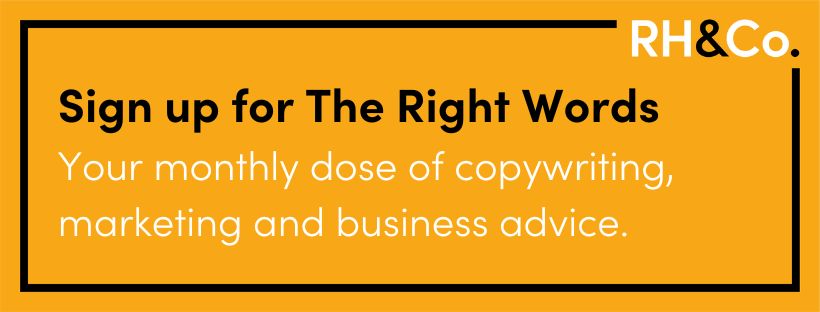
Offer a better version of the future
Once you know what your audience is struggling with or aiming for, you can begin to shape your persuasive argument to address this.
For example, let’s say you have a new HR tech product that makes the staff review process simpler and more efficient. Rather than jumping straight on the various impressive features your product has, paint a picture for your end user.
Help them to imagine what it would be like to spend less time doing face to face reviews. Or to have a happier and more effective team. Ultimately, you want to be able to answer the question “What’s in it for me?”
Persuasion is about stimulating the right emotion
Understanding what a better version of the future looks like for your customer or client is a really useful starting point. Now you have to communicate that message to your audience using words that will engage them, and one of the most effective ways of doing this is to use emotion.
In his book, Persuasive Copywriting, Andy Maslen talks about three main categories of emotion we can use to persuade people.
- Primary or universal emotions such as surprise, fear, happiness and sadness
- Secondary or social emotions such as pride, envy or curiosity
- Tertiary or background emotions such as excitement, calm and tension
Have a look at any given website, advert, flyer or other piece of copy designed to persuade, and you should be able to work out what emotion the copywriter was trying to illicit when they wrote the copy.
Here are a few examples of using emotion as a persuasive technique in website copy we’ve written for our clients:
Petals at Bibendum | pride
This copy we wrote for Petals at Bibendum is designed to appeal to high end customers who have the budget and desire to spend several hundred pounds on flowers without thinking too much about it. The words create a sense that there is an exclusive club and subtly asks whether they belong to that club. In doing so, it appeals to the sense of pride that this audience group would no doubt have about their good taste.
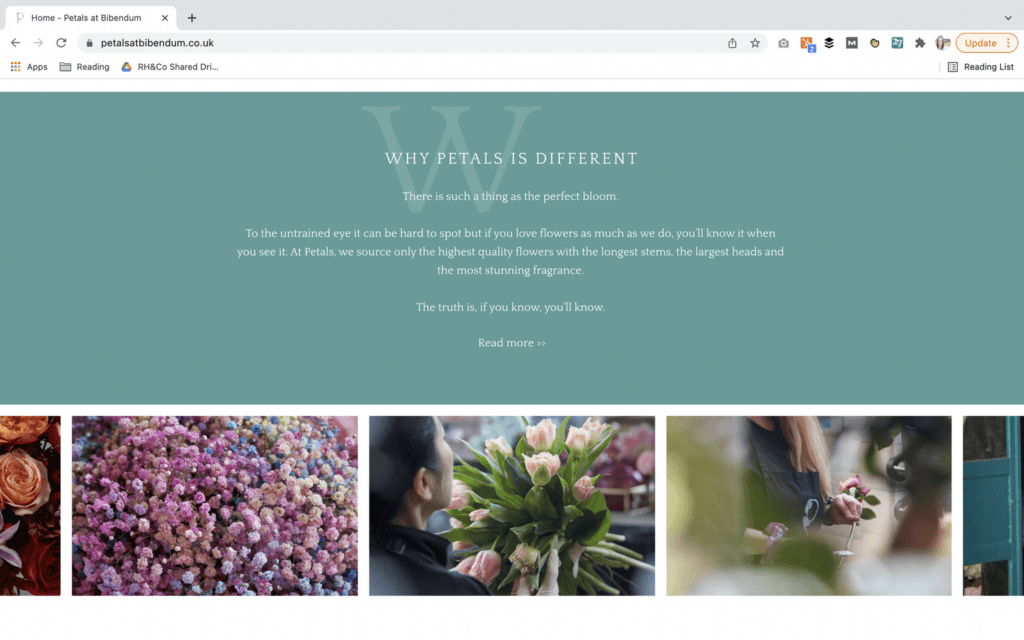
AppLaunch | calm
Developing an app might feel like a stressful, complicated process. The team at AppLaunch wanted to reassure their clients that it didn’t have to be that way. This section of copy encapsulates the simplicity of the process and is designed to create a feeling of calm in the reader, causing them to breathe a sigh of relief.
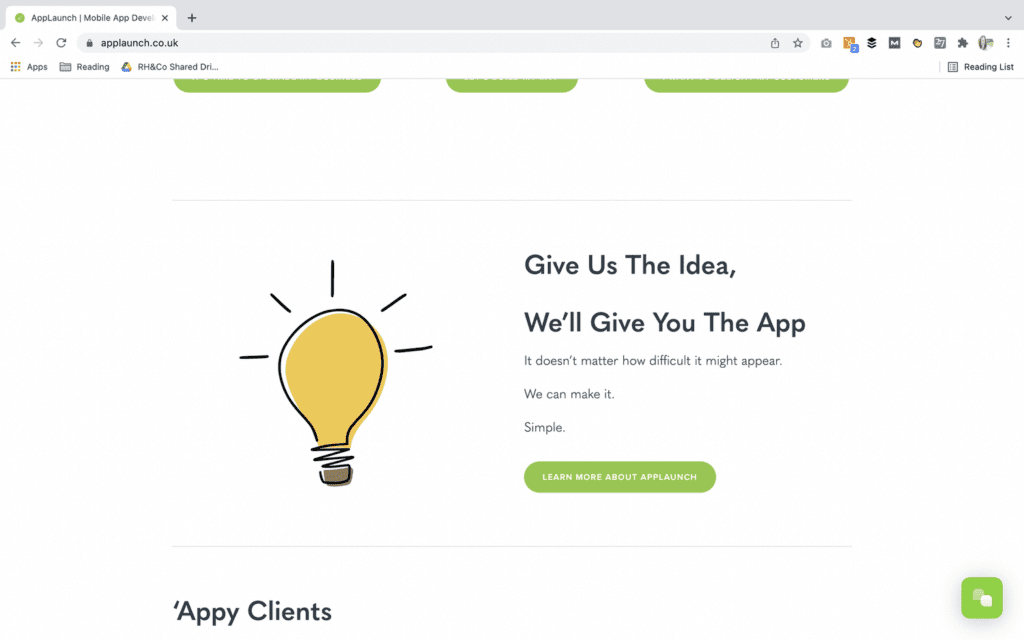
Stylemongers of Bristol | curiosity
Curiosity has got a bad reputation thanks to clickbait headlines that try to hack it in a manipulative way. But appealing to curiosity can be both authentic and very effective, as shown on this sales page we wrote for Stylemongers of Bristol.
Rather than jumping straight into an explanation of what the box contains and why it’s so valuable, the words we use stimulate the reader to use their imagination. Only then do we go into what’s actually in the kit.
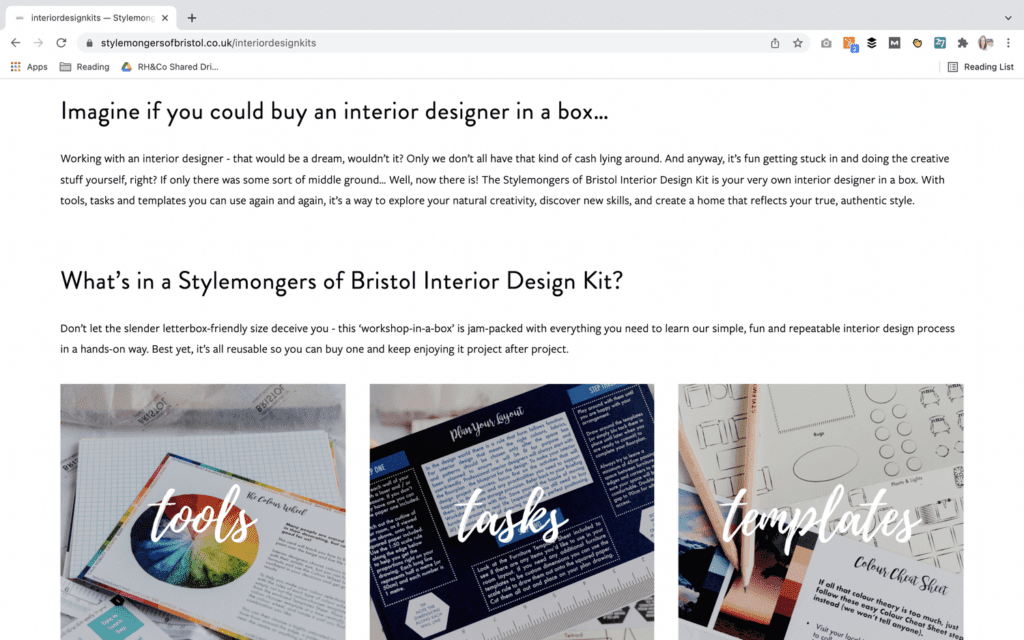
Show, don’t tell
If we’d just described the Stylemongers of Bristol kit as a ‘designer in a box’ without adding more detail, the reader would have been left thinking, “Yes, but what actually is it?”
People make decisions with hearts and minds, so once you’ve used emotion to get their attention, make sure you offer something more substantial too.
And be sure you can prove it. Showing is a far more effective way of persuading someone than telling.
So don’t tell me you’re ‘passionate’ about using local produce at your restaurant – show me what percentage of your ingredients are sourced within a 20 mile radius. Don’t tell me your team building exercises improves staff morale – show me a customer testimonial to prove it or a reputable study that backs your techniques.
Other persuasive writing techniques
We’ve already talked about how emotion is a powerful persuasive technique. Here are a few others to try.
Storytelling
Human beings have always loved stories and they can be used in a number of ways in a persuasive context. For example, case studies are a great way of using client success stories to help persuade your audience by providing social proof. And charities often use stories to persuade people to donate by showcasing real life people who have benefitted from their work.
Your brand story might also be important. You’d think that people would choose a soft drink based on how it tastes, for example. But we know that for Lovely Drinks, their homemade, Somerset roots are integral to their brand and why people choose them, which is why we highlighted this in their website copy.
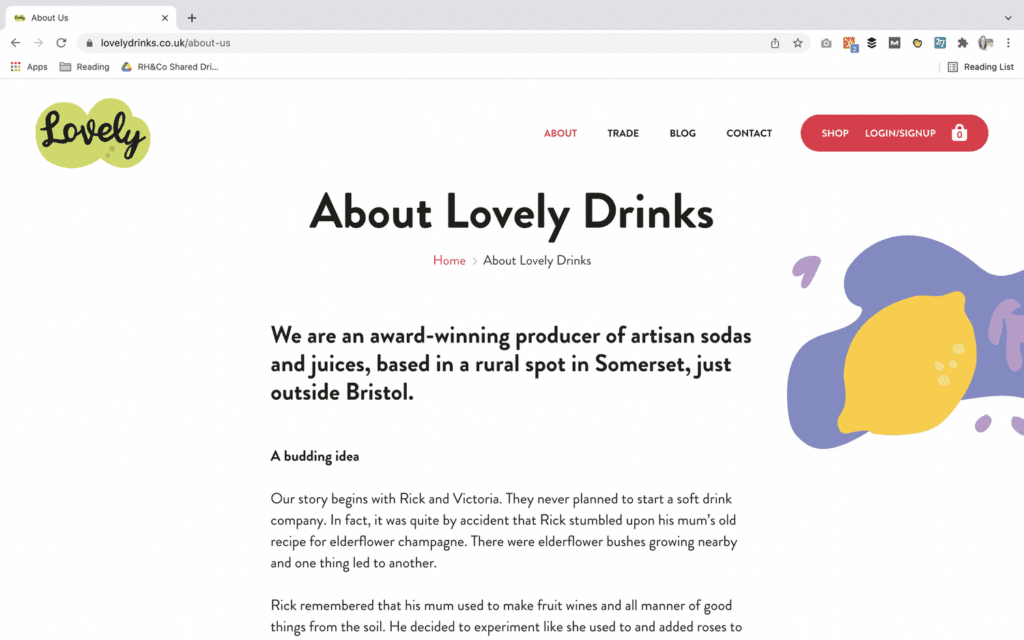
The power of three
There’s something about trios that just work, so long as you don’t overuse them. Whether it’s three words or three sentences, now you know that this is a persuasive writing technique, you’ll start noticing it everywhere. It’s popular in speech writing in particular. And remember ‘Hands, Face, Space’?
We used the power of three on the PlanIt Future website below to build emotion. The first sentence lays out a challenge creating tension. The second builds on it, escalating the tension. Then the third comes in and provides a solution, creating a sense of relief.
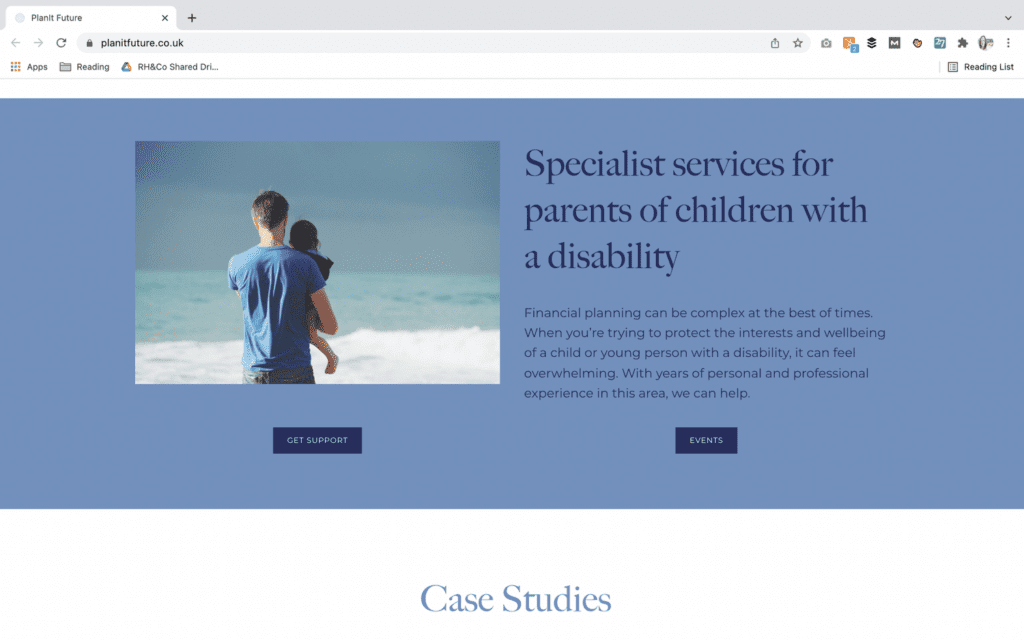
Personalised pronouns
Using personalised pronouns like ‘we’ and ‘you’ establishes a more personalised relationship with your audience. And relationship is essential for persuasion, as we’ll come onto in a moment.
We played on this persuasive technique when we wrote the Engineered Arts website. The line “Humans, check this out” as well as the personalised pronouns further enhanced the sense of conversation between brand and reader.
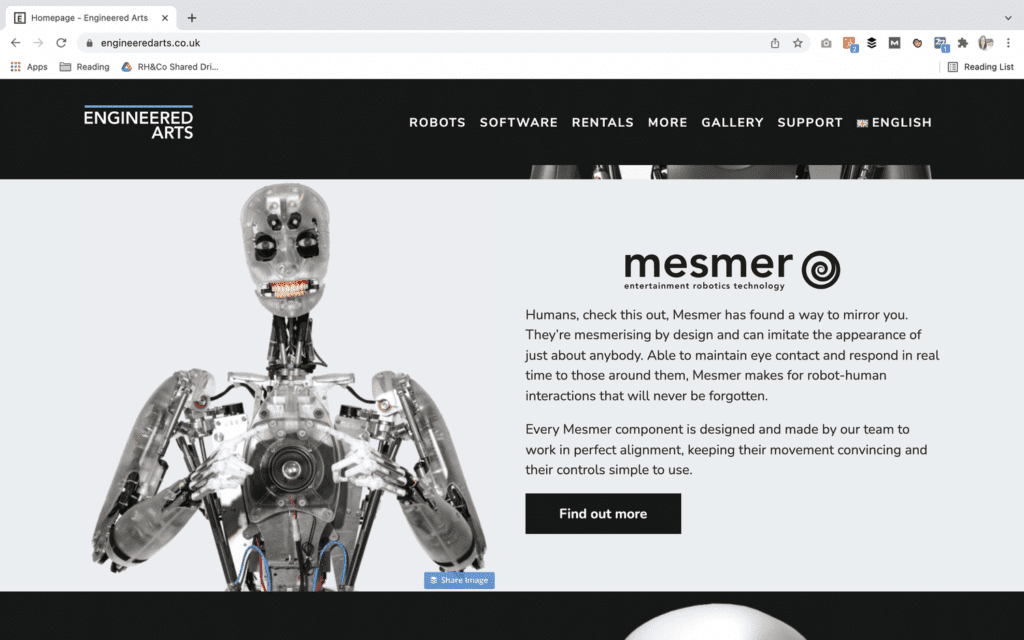
Imagine how different this paragraph would have felt if we’d written, “Engineered Arts has found a way to create robots that mimic people.”
Imperative sentences
An imperative sentence doesn’t have a subject. Instead it begins with a verb. Imperative sentences are also known as command sentences, and they are ideal for persuading people to act. This is why calls to action (CTAs) are usually imperative sentences.
Here’s a good example from Garrett Creative where we used a double CTA, both using imperative sentences, to create options for visitors at different stages of their customer journey.
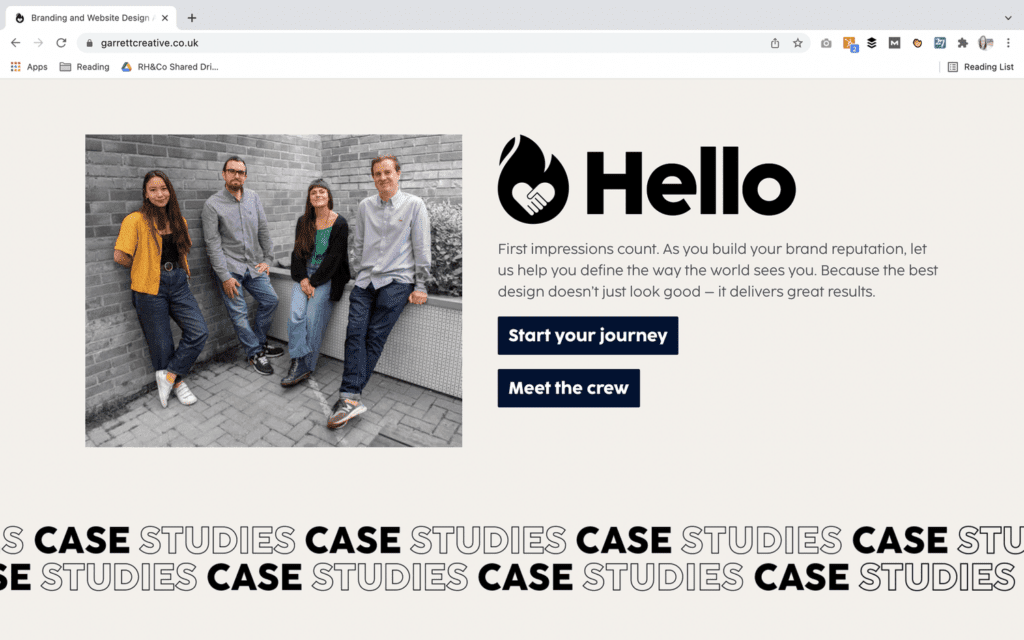
Building relationships – the importance of timing
Last but not least, persuasion isn’t just about what words you use. It’s also about when you use them. Because if you go in too hard, too early, you’re going to come across like a pushy car salesman.
The most effective persuasion comes from a foundation of relationship. We’re not enormous fans of Gary V’s ‘Jab, jab, jab, right hook’ analogy as we’d rather not paint marketing and sales as a violent sport! But the principle is sound. It’s all about adding value for your audience and earning your right to ask for what you want.
You also need to know where your customer is on their journey. If they’re only just figuring out that they have a problem, don’t jump straight in and try to shove your solution down their throat.
Help them explore the problem and understand it fully, perhaps with a blog post, video or webinar. Showcase the broad types of solution available and the advantages and disadvantages of each. Maybe now they’re ready to give you their email in return for a useful download.
The more complex, important or expensive a buy decision is, the longer it’s likely to take. Which means you might need to adjust your perception of persuasion as a ‘get them over the line’ approach.
Persuasive writing can have an instant effect, of course – we’ve all bought something on a whim because we were hooked by a clever advert from a brand we’ve never heard of. The important thing is to understand where that’s possible and plan for the times when it isn’t.
If you know your audience and what they’re looking for, if you speak to both their heart and their head, and if you let them come to you in their time, you’ll have far more success than if you resort to being pushy.
Whatever copywriting project you’re embarking on – whether it’s website copy, a chunky white paper or a series of expert led blog posts – there will come a point when you need give your copywriter feedback.
You might think that in a perfect world you’d be happy with each and every word they presents in their first draft, but the reality is that the chances of this are practically zero – especially if you’re at the beginning of your working relationship. It may be the copy needs just a few tweaks that are easy enough to make, or there might be broader issues around messaging, structure or tone that you’re not 100% happy with.
So how do you give feedback in a way that will ensure that your second draft copy is that much closer to what you’re looking for? Here’s what we’ve learned over the years, from a writer’s perspective.
TL:DR
- Remember that we’re not taking it personally
- Does it meet the brief?
- Be realistic about what’s possible
- Feeding back on messaging, structure and tone
- Broad vs detailed feedback and how to deliver it
- The practicalities – tracked changes and comments
- Signing off your copy
Remember that we’re not taking it personally
This is a really important point to start with. A lot of people find giving feedback uncomfortable, as it feels like they’re being critical and that doesn’t come naturally to a lot of people. But as copywriters we expect to get guidance from our clients in terms of what’s working for them and what isn’t.
After all, writing is as much an art as a science. There’s an element of subjectivity, and what works for one person won’t always work for another. Our perceptions of what constitutes “formal” or “humorous” or “disruptive” might be different from yours.
So try to take the emotion out of it and simply be as clear as possible about what you do and don’t like so that the next draft is better. That said, positive framing is always nicer to receive than blunt negativity! Try “need something less technical here” instead of “this is way too complicated”.
“From the outset, it’s important to be realistic about what your copywriter will be able to achieve with the tools they’ve been given.”
Does it meet the brief?
Having said that you should be clear about what you do and don’t like, the main thing to consider is how well the copy meets the brief. After all, you’re not the target reader and part of why you’ve hired a copywriter or copywriting agency is to bring an outside perspective.
For example, you may have asked for a technically complex piece that still needs to be accessible to a non-technical audience. In which case, don’t be surprised if the copy is simplified and not as nuanced as you – the expert – understand it to be.
Of course, creating a good, detailed brief is part of what your copywriter or agency should be able to help you with. Ideally, work on it collaboratively and sign it off before any writing work starts so everyone is on the same page as to what good should look like.

Be realistic about what’s possible
From the outset, it’s important to be realistic about what your copywriter will be able to achieve with the tools they’ve been given.
Imagine, for example, you’re the marketing manager and your company’s subject matter expert isn’t available to come to the briefing and input their insights. Naturally your copywriter is going to have a hard time creating a unique piece of thought leadership content.
The same is true if you haven’t yet clarified your thoughts about the value proposition of your product or service. Your copywriter is going to struggle to articulate them in your first draft copy without first doing some messaging work with you.
Feeding back on messaging, structure and tone
There are three overarching elements that you can consider as you put together your feedback notes or prepare for a feedback session. By understanding the differences, you can be that bit more accurate about which elements you need your copywriter to work on.
First, messaging. If you had to summarise the point of your blog post in a few words, what would it be? What’s the key takeaway you want people to get from your website copy? If these aren’t correct, then nothing else will be so it’s important to get them right – ideally before the writing even starts.
Structure is about how the key elements of your copy are laid out. This might be the order that you tackle your main points in a blog post, the way you segment your services on your website home page, or simply how copy-heavy different elements of your white paper are.
Finally, tone is about the actual words used and the impression they give about the brand’s personality, levels of formality and so on. It’s whether you’re asking people to ‘check out our sizzling deals’ or ‘take a look at our exclusive offers’, for example.

Broad vs detailed feedback and how to deliver it
There are two general types of feedback. Broad feedback might be your overarching thought about, for example, the angle of your blog post not quite being right. Perhaps the copywriter has taken one point that you made in the briefing and built too heavily on it, skewing the overall feel of the piece.
In this case, a conversation might be the easiest way to give your amends. It’ll mean they can ask more probing questions to get to the bottom of why the first draft isn’t quite working.
But sometimes broad feedback isn’t helpful. If you think the tone is “too formal”, for example, it’s helpful to highlight words and phrases in the copy that demonstrate this, making notes in the document. As we’ve said, your understanding of what formal looks like might be different to your copywriter’s.
The practicalities – tracked changes and comments
When it comes to adding feedback into a first draft copy document, there are two different options, which we’d suggest using together. This applies for any text based document, whether you’re using Google Docs (as we do) or Word or something else.
The first is the comments function. This allows you to highlight a sentence or paragraph and say something like “too wordy” or “can we give an example here?” without having to do any rewriting. Remember that you’re paying your copywriter for a reason, so don’t do more work than you have to.
If you do want to tweak any wording yourself, use the ‘tracked changes’ function – in Google Docs this would be editing in ‘suggestion mode’. This gives your copywriter a chance to check the changes for errors and will also help them learn about your preferred style. This is particularly important if you’re building an ongoing relationship.
And if you are entering into a longer term relationship with a copywriter or copywriting agency, then highlighting what you like – as well as what you don’t – is very useful too.
Signing off your copy
Most copywriters and copywriting agencies will build in a couple of amends stages into each project as standard, depending on the size, complexity and importance of a project. By being as clear and as detailed as you can in the first round of amends, you should find that by the second round you’re down to much more minor tweaks.
If your copy is being designed in some way – for example, if you’ve commissioned a website or brochure – you might want to ask your copywriter to give the content a final once over at the design proof stage. This allows them to catch any errors that might have crept in and potentially help you adjust the length of the copy to fit the design, if that’s needed.
Once you’re completely satisfied with your copy, it’s time to sign it off officially. After this point, if you need any further changes, this will generally be seen as an additional job.
If you’re happy with how your project has gone, don’t forget to tell your copywriter or agency. It’s always nice to get positive feedback! But more importantly, they should be making notes about all the feedback they’ve received so that next time you need some support, they’ll be ready to go. The first draft of your future projects should need far less in the way of amends than the original copy did.
If you say you’re good at what you do, people might be a little sceptical. If someone who has used your business says you’re good at what you do (i.e. gives you a testimonial), that’s more convincing. And if you set that endorsement within a wider context that lays out what exactly was achieved (i.e. a case study), you’re onto a real winner.
We all know that storytelling is a powerful way to engage people. The human race has been using stories – to entertain, to teach, to persuade – since the dawn of time. Good stories use the ‘show, don’t tell’ method of communication to bypass our conscious mind and tap into something much more primitive.
That’s why case studies are so effective. Or rather, why they can be so effective – if they’re done well. This is a guide for business owners and marketers who want to create genuinely effective case studies that get results.
TL:DR
- How to pick the right subject for your case study
- Transformation and benefits – the absolute essentials
- Taking it to the next level
- How to interview a client for a case study
- How to make your case studies more engaging
- How to get more eyes on your case studies
- Effective case studies – a conclusion
How to pick the right subject for your case study
Naturally when it comes to choosing the right subject for a case study, you want an example where you can show that you delivered excellent results. You’ll also need to make sure that the customer or client in question is happy to put their name to it and, ideally, get actively involved (more on that later).
Beyond this, the main thing to think about is whether the example you’re considering is a good reflection of your ideal customer, client or project. The point of a case study is to attract more of the same sort of work, so if a job wasn’t all that profitable, for example, then don’t feature it, even if the results were good.
The best case studies are the ones that highlight a particular benefit you want to promote, which are in a sector you’re planning to pursue, or have some other feature that makes them a beacon for the kinds of work that you most want to do.
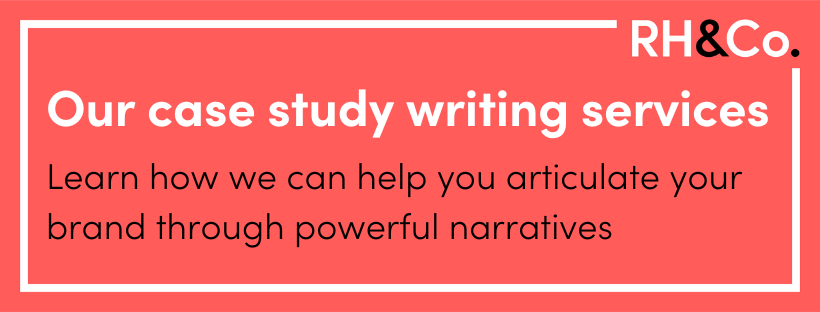
Transformation and benefits – the absolute essentials
The most important element of a case study is the transformation. You want to start out by showing the reader the situation your customer or client was in when they first engaged with your business.
Ideally, this will be a problem that they recognise themselves. Something that makes them think, “Yes, this is exactly what I’m struggling with!” Something that will compel them to keep reading because they want to know what the solution is.
Then, you want to finish with the positive difference that working with you or using your product had on their lives. That contrast – the transformation – is the foundation that every case study should be built on.
Just be sure that you’re not limiting your transformation to the practicalities. We need to go beyond features here, and focus on benefits.
For example, if you designed a new piece of software that achieves a key admin task in half the time of the manual process, that’s great. But make sure that you also talk about how customer experience has improved thanks to the faster service, and employees are happier now that they’re not spending half their day doing tedious admin tasks.
“ You can create the most powerful and well written case study in the world but if it isn’t easy to read, most people are going to give up after a couple of lines.”
Taking it to the next level
Now that you’ve got the foundations in place, you want to start building up layers of evidence that support your case study.
Hard facts
Any empirical facts that you can include will add weight to your assertions. In the example above, don’t just talk about customer experience improving – tell the reader that the client’s average Trustpilot score has increased from 4.2 to 4.8. Or that their staff turnover is down 15% on the previous year.
Direct quotes
Direct quotes are another useful way to back up your assertions, especially if your case study doesn’t naturally lend itself to tangible numbers.
In one of our case studies, our client Vaq Hussain, marketing manager at Actual Experience, said, “I would say Rin Hamburgh & Co’s strengths are not just in their writing. Rin and her team are excellent listeners. Finding the important details in what we were telling them, understanding the relevance to our audience and converting it to a usable content piece is what impressed me the most.”
If we say we’re good listeners, there’s no reason for you to believe us. If someone else says it, it’s far more convincing.
Other formats
You can also build on your case study by using a range of formats. If your customer or client is willing to give you quotes to include, why not ask them to record a video so you have a visual testimonial to share?
Or if you have lots of great facts and figures, turn them into infographics. These are easy to share, quick to process and perfect for a time-poor audience that wants to engage quickly with your content.
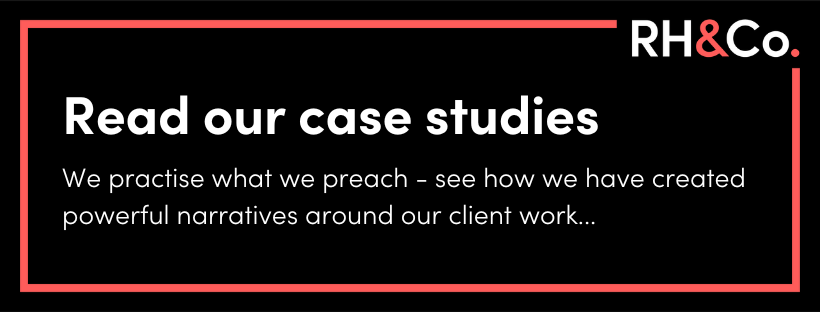
How to interview a client for a case study
If you want to use first person quotes for your case study, you’ll need to think about how to get the information you want from them. Simply asking them to write a few lines or paragraphs about their experience with you is going to get mixed results at best.
At the very least, make sure to email over a list of questions that encourages them to explore the aspects you want to focus on. For example, ask them to describe the problem that they were facing when they came to you, so you have the base for your transformation story.
If you particularly want to highlight an aspect of your product or service, make sure one of the questions leads to that. Perhaps you know that your machinery operates much more quietly than most. Be sure to ask, “How has using X impacted on noise levels at your site?”
The best scenario, however, is to actually ask your questions live. That way you can use follow up questions to explore interesting lines that emerge as you talk. Often the best and most useful nuggets of information come from pursuing what was originally a throwaway comment.
If it doesn’t feel natural to conduct an interview like this in-house – and it’s true that it can be a bit awkward to ask people to say nice things about you to your face – you can use a freelance marketer or agency such as RH&Co to do it for you.
How to make your case studies more engaging
You can create the most powerful and well written case study in the world but if it isn’t easy to read, most people are going to give up after a couple of lines. Structuring an engaging case study is very much like structuring an engaging blog post.
Subheads
Use subhead to stop the ‘scary wall of text’ effect, which is a sure fire way to put off a busy reader. Subheads can be functional, clearly showcasing what each section contains e.g. The Challenge, The Solution, The Result. Or they can be more conceptual, drawing out elements of the story.
Images
Another way to break up solid text is by using images. Some case studies will naturally lend themselves to imagery – for example, if you run an event business, you can use photographs taken at the event you’re highlighting. But more generic brand images can also work to create interest on the page – see our case studies as an example.
If your case study contains data, you can represent this visually. It doesn’t have to be a full infographic; a graph or pie chart can be enough to lift a page that would otherwise look dull or impenetrable.
Pull quotes
This refers to a single line or short paragraph of text that is highlighted in a different font size and / or colour to help it stand out from the rest of the copy. Like graphics, these provide ‘entry points’ into the page, stopping your reader from scrolling and hooking their interest so that they read more.
How to get more eyes on your case studies
Of course, in order for your readers to engage with your case studies, they first need to know that they exist. That’s why it’s important that you make them as easy to find as possible.
Optimise them for SEO
A byproduct of formatting your case study well with images and subheads is that you will add great SEO value. For images, make sure you’ve included the right keywords in both the image files and the alt text. Other areas to focus on include meta descriptions and the case study URL itself.
Make them prominent on your website
If you have a decent selection of case studies, you should have a dedicated spot on your website where your visitors can go and look through them. This should be easy to find via the menu on your website.
But don’t stop there. Use a panel on your homepage to showcase highlights and include a strong call to action to lead people through to the case study page. You can include relevant highlights on product, services and industry / sector pages too.
Share them on social media
As with blog posts, there are various ways to share your case studies. Don’t just push them out once and then forget about it. Draw out different elements of the story, share testimonial quotes and hard facts, ask questions to find out what struggles your audience is facing. And remember to tag the company and individual(s) involved so that you increase your reach.
Use them in your emails
If you’ve got a newsletter, you can use it as a platform to share new case studies as you publish them. But there are more powerful ways to use case studies in emails too.
If you use lead magnets, for example, make sure to use case studies within your nurture sequences. You can also use them within direct sales emails as a way to help overcome objections and move leads through the buying journey.
Effective case studies – a conclusion
To be effective, a case study needs to do five things.
- Be easy to find, be that on social, via search or for visitors coming to your website.
- Be easy to read. Forget an off putting wall of text. Use images, subheads and pull quotes to create entry points for your reader.
- Be built around a foundation of transformation that highlights the end benefits of your products and services.
- Speak to your ideal audience, drawing in clients who will benefit your business (and vice versa) and putting off anyone who wouldn’t be a good fit.
- Stand out from the crowd and be memorable. Use infographics or video to make an impression, and facts and testimonial quotes to back up your assertions.
If you can get your case study firing on all five cylinders, it can be an incredibly powerful tool in your marketing and sales toolkit. For support in creating case studies for your business, get in touch with us on talktous@rin-hamburgh.co.uk or call 0117 990 2690.

